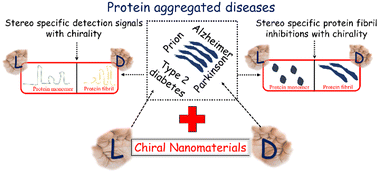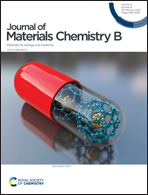Chiral nanomaterial-based approaches for diagnosis and treatment of protein-aggregated neurodiseases: current status and future opportunities
Abstract
Protein misfolding and its aggregation, known as amyloid aggregates (Aβ), are some of the major causes of more than 20 diseases such as Parkinson's disease, Alzheimer's disease, and type 2 diabetes. The process of Aβ formation involves an energy-driven oligomerization of Aβ monomers, leading to polymerization and eventual aggregation into fibrils. Aβ fibrils exhibit multilevel chirality arising from its amino acid residues and the arrangement of folded polypeptide chains; thus, a chirality-driven approach can be utilized for the detection and inhibition of Aβ fibrils. In this regard, chiral nanomaterials have recently opened new possibilities for various biomedical applications owing to their stereoselective interaction with biological systems. Leveraging this chirality-driven approach with chiral nanomaterials against protein-aggregated diseases could yield promising results, particularly in the early detection of Aβ forms and the inhibition of Aβ aggregate formation via specific and strong “chiral–chiral interaction.” Despite the advantages, the development of advanced theranostic systems using chiral nanomaterials against protein-aggregated diseases has received limited attention so far because of considerably limited formulations for chiral nanomaterials and lack of information of their chiroptical behavior. This review aims to present the current status of chiral nanomaterials explored for detecting and inhibiting Aβ forms. This review covers the origin of chirality in amyloid fibrils and nanomaterials and different chiral detection methods; furthermore, different chiral nanosystems such as chiral plasmonic nanomaterials, chiral carbon-based nanomaterials, and chiral nanosurfaces, which have been used so far for different therapeutic applications against protein-aggregated diseases, are discussed in detail. The findings from this review may pave the way for the development of novel approaches using chiral nanomaterials to combat diseases resulting from protein misfolding and can further be extended to other disease forms.

- This article is part of the themed collection: Journal of Materials Chemistry B Recent Review Articles


 Please wait while we load your content...
Please wait while we load your content...